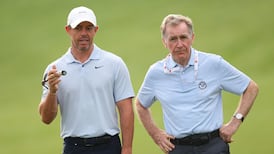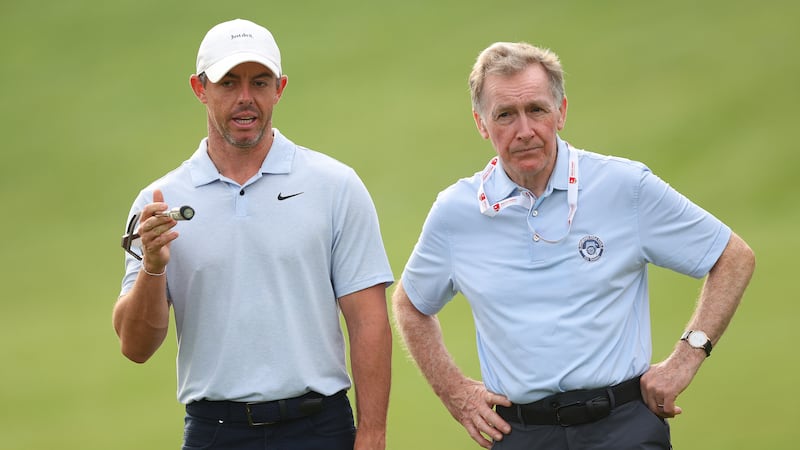Round 1 – Thursday, July 17th
There’s an old adage about the luck of the draw; there’s another about making your own luck: in the first round, Rory McIlroy took both of them to heart! On a day when the first wave of players benefited from the most favourable weather conditions, the Ulsterman was sublime in shooting a bogey-free opening round 66, six-under-par.
There was a strut about McIlroy, as he exuded confidence in everything he did. After each good shot, and there were many, the trademark twirl of the club in his hands confirmed the ball was on the correct flight-path. His first birdie came on the second hole and back-to-back birdies on the fifth and sixth contributed to him turning in 32 strokes.
0 of 4
In advance of the championship, McIlroy had targeted the Par 5s as key to success. He put his words into action, with birdies on the fifth, 10th and 16th holes - and the only Par 5 that he failed to conquer was the 18th, where he had to be satisfied with a par.
No harm done: he had taken the first round lead, by a stroke over Italy's Matteo Manassero with a group of players – among them world number one Adam Scott – poised a shot further adrift.
Round 2 – Friday, July 18th
McIlroy suffered his first bogey of the championship on the first hole of his second round, after hitting his approach over the back of the green. Fears of the so-called "Freaky Friday" syndrome? Not at all, for the player banished such a phobia with an accomplished second round of 66 for 132 that gave him the midway lead, by four strokes over Dustin Johnson.
That bogey was the only blemish on McIlroy’s scorecard.
He got his first of seven birdies of the round on the fifth – reaching the Par 5 in two and two-putting from 40 feet – and also took the breaks that came his way, particularly on the 14th where his tee-shot landed in the rough and somehow kicked back out onto the fairway.
McIlroy went about his business with aplomb, recovering from the opening bogey to claim birdies on the fifth, sixth an, the eighth. He turned in 33 and added further birdies on the 10th, 15th, 17th – where he hit a 396- yard drive – and completed his work with a finishing birdie on the 18th to show his dominance.
There was a calmness about his demeanour, an assuredness about all that he did. McIlroy said he was in the zone, revealing that he had two trigger words to keep him on the right track, mentally. “It’s just a state of mind where you think clearly. Everything seems to be on the right track. I’ve always said, whenever you play this well, you always wonder how you’ve played so badly before. And whenever you’ve play so badly, you always wonder how you play so well. Golf’s a very fickle game.”
Round 3 – Saturday, July 19th
When he needed to, as his old pal Rickie Fowler threatened at one stage to spoil the party, McIlroy moved up the gears and sped away from everyone.
Twice in the closing stages of a round of 68 for a 54-hole total of 200, 16-under-par, McIlroy punched fist pumps into the air after sinking putts for eagles on the 16th and 18th greens.
On each occasion, his muscles – toned from rigorous gym workouts which have transformed his body – rippled under his Nike top as if to signal that the boy wonder had grown into some kind of superman.
On a day when the R&A took the decision to cram the field into three-balls with a two-tee start to beat the forecasted thunderstorms, McIlroy worked his magic for a third successive day with the two late eagles enabling him to fly majestically away from his pursuers.
On the 16th, he hit a four-iron approach from 248 yards to 20 feet and made the eagle; on the 18th, he hit a five-iron approach from 237 yards to 10 feet and rolled in the putt as if saluting his own destiny.
The two eagles seemed to send out a message to all-comers to keep their distance.
Round 4 – Sunday, July 20th
McIlroy drove into the car park of Royal Liverpool shortly before 1pm, just over two and a half hours before his tee-time. By the time he walked to the first tee, with a six-shot cushion over Rickie Fowler, McIlroy had gone through his routine. Now, all he had to do was to finish the job on the course. As it transpired, it was the man in front - Sergio Garcia emerged as his chief pursuer, the Spaniard's eagle on the 10th cutting McIlroy's advantage to two strokes.
Garcia put it up to McIlroy with, putting together a final round of 66 which – on the day – was five better than the Ulsterman. But it wasn’t enough. McIlroy, with a rather conservative game plan, wasn’t as swashbuckling as he was for the opening three rounds. Although opening with an 18-footer for birdie on the first, a putt struck with assertiveness, McIlroy subsequently hit some bumps on the road to victory: back-to-back bogeys on the par five fifth and par three sixth led to some tension. The swing wasn’t as smooth, the stride so purposeful. Suddenly, it seemed, the march to the Claret Jug wasn’t so straightforward after all.
Garcia upped the ante with an eagle on the 10th and also had got an element of good fortune on the 12th where his approach hit the grandstand and bounced back to the edge of the green. Was fate on Garcia’s side this time? In effect, McIlroy – who bogeyed the 13th with a poor tee-shot short of the green into heavy rough – took matters into his own hands with a monstrous drive of 360 yards down the 16th to set up a birdie that restored his three-stroke lead. A par-par finish didn’t have any of the drama of his third round, but it left him with a two-stroke winning margin over Garcia and Fowler.





















